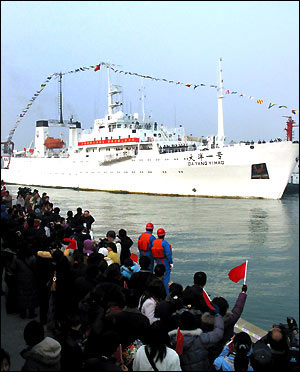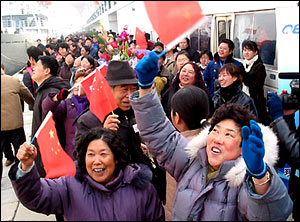| Tools: Save | Print | E-mail | Most Read |
| Successful Voyage for Scientific Research |
| Adjust font size: |
China's first scientific research ship to circumnavigate the globe returned home yesterday after 300 days at sea. The mission has fulfilled the long-held Chinese dream to make a transoceanic voyage, and also brought back more than 1,000 kilograms of hydrothermal sulfide samples containing copper, zinc and precious metals such as gold and silver. Setting off from east China's coastal city Qingdao last April, "Dayang Yihao (Ocean No. 1)" traveled 43,230 nautical miles (79,975 kilometers), first visiting the Pacific and then sailing across the Atlantic through the Panama Canal. It then traveled to the Indian Ocean, rounding the Cape of Good Hope before heading back for the Pacific through the Straits of Malacca. "The distance is the equivalent to circling the equator twice," Lu Huisheng, 40, captain of the vessel, said. The expedition was divided into six working trips with five stopovers, including Micronesia, Mexico, South Africa and Singapore for supplies of fuel, drinking water and fresh food. Chinese scientists gathered many rock samples, monitored and mapped out the ocean floor for future deep-sea mining operations and also conducted deep-sea biological research such as investigating, collecting and classifying sea life samples. Han Xizhu, assistant to the chief scientist in the trip, said studies on the distribution of hot liquid sulfides on the sea floor were carried out to accumulate data for further development and exploitation. "First-hand data of life formations near thermal vents are also a focus of the research mission, as biological gene study in this extreme environment might help in the fight against disease," she said. Marine analysts said the trip marks the first step in the efforts of Chinese scientists to expand their reach to all major oceanic areas and to transform their focus from field research of mineral and biological resources to all-purpose studies, including advanced equipment testing and professional training. About 120 scientific researchers, including several scientists from the United States and Germany, took part in the mission, but only two women, Han being one of them. "Life aboard a research ship is not normal," she said. "You've got to work, work and work and there is no perception of time, even though the days on the calendar change."
(China Daily January 23, 2006) |
| Tools: Save | Print | E-mail | Most Read |
 |
| Related Stories |
| Product Directory China Search |
Country Search Hot Buys |


